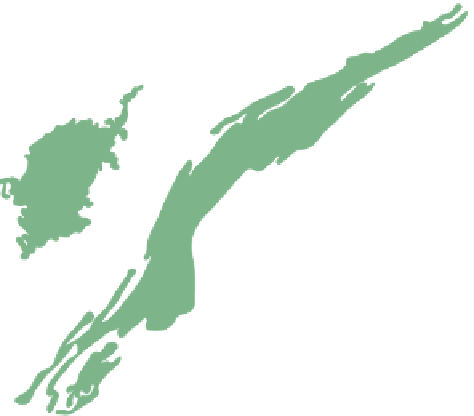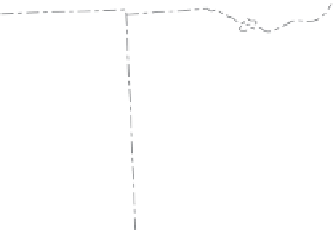Geology Reference
In-Depth Information
80
°
W
85
°
W
MICHIGAN
BASIN
Pennsylvania
40
°
N
Ohio
40
°
N
Indiana
West
Virginia
ILLINOIS
BASIN
Virginia
Kentucky
Outcrop of
Upper Ordovician
strata
North Carolina
Tennessee
35
°
N
35
°
N
South
Carolina
N
BLACK
WARRIOR
BASIN
Alabama
Georgia
0
100
200
300
km
80
°
W
85
°
W
Fig. 2.
Map of study area, showing outcrop belts of Upper Ordovician rocks in green, as well as the locations of principal
structural features in the region. Contours of Upper Ordovician sediment thickness in the Martinsburg and Sevier basins
are indicated.
THE CINCINNATI ARCH AND
APPALACHIAN FORELAND BASIN
Fig. 2). The Middle to Upper Ordovician records
the foundering of the Cambrian-Early Ordovician
passive margin (Knox Group) of eastern North
America (Read, 1989). This attempted subduction
of the eastern margin of Laurentia under a volcanic
arc/accretionary wedge complex (Rodgers, 1971;
Drake
et al
., 1989) created a westward-migrating
peripheral bulge that produced the regional Knox
unconformity and a foreland basin extending
from Alabama to Newfoundland (Jacobi, 1981;
Mussman & Read, 1986; Lash, 1988). The global
correlation of the Knox unconformity overlapping
with the Sauk-Tippecanoe boundary (Sloss, 1963)
also points to a eustatic role in its generation.
The Cincinnati Arch is interpreted to be the
peripheral bulge of the Appalachian foreland
basin, which formed by collision of Laurentia
with a magmatic arc (Quinlan & Beaumont, 1984;
Ettensohn, 1992). The Jessamine and Nashville
Domes on the Cincinnati Arch are further inter-
preted to have formed from overlapping peripheral
bulges, generated by orogenic and sedimentary
loading in the Appalachian foreland basin and by
sedimentary loading in the intracratonic Michigan
and Illinois Basins (Quinlan & Beaumont, 1984;


































































































































